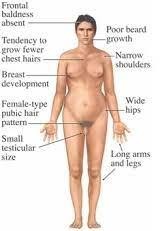While assessing a male client, a nurse observes that the client has a small penis, long legs, short trunk, enlarged breast tissues, small testicles, and sexual dysfunction. What diagnosis does the nurse suspect from these findings?
Cri du chat "cry of the cat,"
Klinefelter syndrome
Patau syndrome
Turner's syndrome
The Correct Answer is A
Choice A rationale: Cri du chat syndrome involves a high-pitched cry in infants and other distinct physical and developmental features, but it doesn't present with the described symptoms.
Choice B rationale: Klinefelter syndrome, characterized by an extra X chromosome (XXY) in males, typically presents with small testicles, gynecomastia (enlarged breast tissues), sexual dysfunction, and altered body proportions, such as long legs and a shorter trunk, aligning with the client's symptoms.
Choice C rationale: Patau syndrome (Trisomy 13) manifests with severe developmental issues, facial abnormalities, and other physical malformations, but the described symptoms are not typically associated with this syndrome.
Choice D rationale: Turner syndrome involves females with a missing or partially missing X chromosome (45, X), resulting in specific physical features and medical problems not consistent with the described symptoms in a male client.

Nursing Test Bank
Naxlex Comprehensive Predictor Exams
Related Questions
Correct Answer is A
Explanation
Choice A rationale: Arterial blood gas (ABG) findings provide direct information about oxygenation and acid-base balance in the blood, which can indicate hypoxemia and metabolic acidosis.
Choice B rationale: Oxygen saturation level provides information about oxygen saturation in the blood but doesn't give a complete assessment of acid-base balance or other gases in the blood.
Choice C rationale: White blood cell differential assesses different types of white blood cells and is not directly related to evaluating hypoxemia or metabolic acidosis.
Choice D rationale: Red blood cells (RBCs) and hemoglobin count findings are important but do not directly assess hypoxemia or metabolic acidosis.
Correct Answer is A
Explanation
Choice A rationale: Yeast vaginitis, commonly known as a yeast infection, is typically caused by an overgrowth of Candida albicans, a type of fungus. Candida albicans overgrowth can lead to symptoms like white, thick discharge and itching in the vaginal area.
Choice B rationale: Lactobacillus acidophilus is a bacterium associated with maintaining vaginal health rather than causing yeast infections.
Choice C rationale: Escherichia coli is a bacteria that can cause different types of infections but are not typically associated with yeast vaginitis.
Choice D rationale: Neisseria gonorrhoeae is a bacteria and does not cause yeast vaginitis despite having similar presentation such as pus discharge per vaginally.
Whether you are a student looking to ace your exams or a practicing nurse seeking to enhance your expertise , our nursing education contents will empower you with the confidence and competence to make a difference in the lives of patients and become a respected leader in the healthcare field.
Visit Naxlex, invest in your future and unlock endless possibilities with our unparalleled nursing education contents today
Report Wrong Answer on the Current Question
Do you disagree with the answer? If yes, what is your expected answer? Explain.
Kindly be descriptive with the issue you are facing.
